- What is a narrative map?
- Organize your campaign by narrative maps
- The Summary Sheet
- The scenarios
- The places
- The Two Formats of the Narrative Map
- The Origin of the Narrative Map
- The Evolution of the Template
What is a narrative map?
The narrative map is a resource for game directors that combines a grid map with a campaign book. Just like with grid maps, a narrative map allows you to add scenery, but you can also write dialogues, control combat, or create puzzles for your One Shot.
Organize your campaign by narrative maps
A narrative map is divided into 3 scenarios. Each scenario includes a maximum of 7 places, which limits your creation time and game time. So if you have little time you can cover what you need for the game and avoid getting lost in a gigantic forest of ideas without defined space.
But a narrative map not only allows you to create a short adventure or One Shot, it also gives you the possibility of grouping several narrative maps to create a role-playing campaign. How? By numbering each one individually so that you can organize them from the first to the last. And, to help you understand how to use one, we summarize what each section of the narrative map is for and leave you at the end of this post a template in Word.
The Summary Sheet
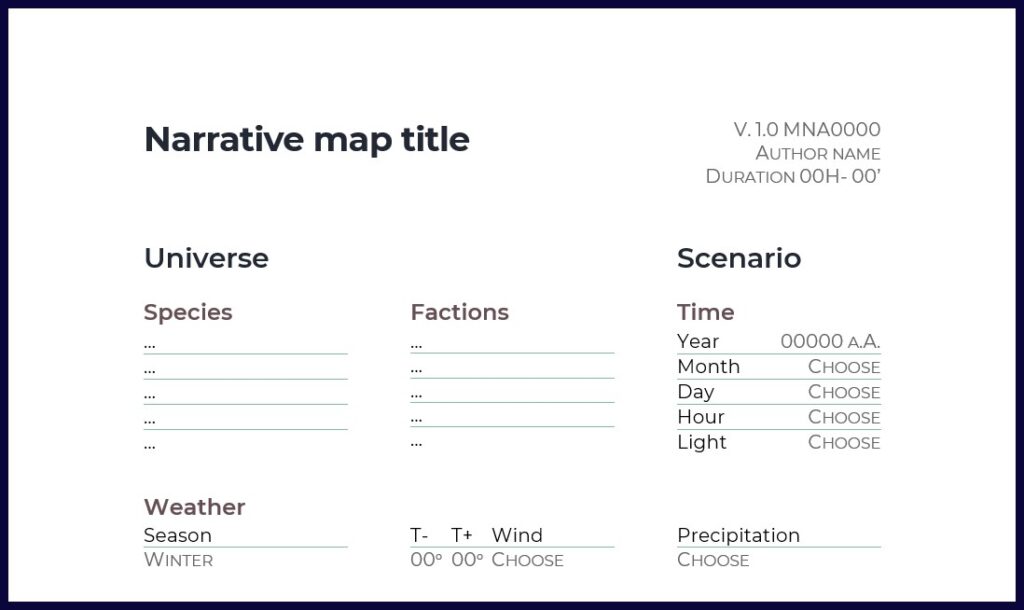
It helps you define the general content that your One Shot will have. You can set the main scenery, the rewards that can be obtained, and what the plot will be like. It is divided into the following sections:
- Universe: select the species and factions that will coexist during the narrative map.
- Scenario: establish at what time everything happens and what climate will accompany it.
- Scenery: choose the biomes you want and select the traps and puzzles.
- Rewards: add everything that can be found throughout the narrative map.
- Plot: establish the premise, objectives, scenarios, NPCs, plot, and plot twist.
The scenarios
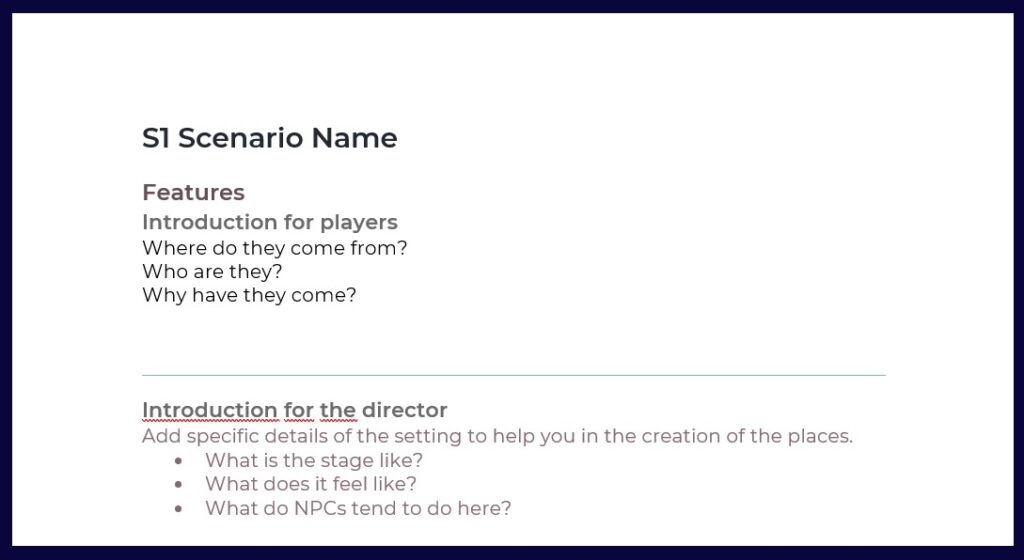
The narrative map allows you to define the basic content of each scenario. Before delving into the places that make them up, you have a page at your disposal to describe narratively what that scenario is like. In addition, you can assign the goal to be achieved, the plot twist that may happen and organize the places of the scenario visually.
The places
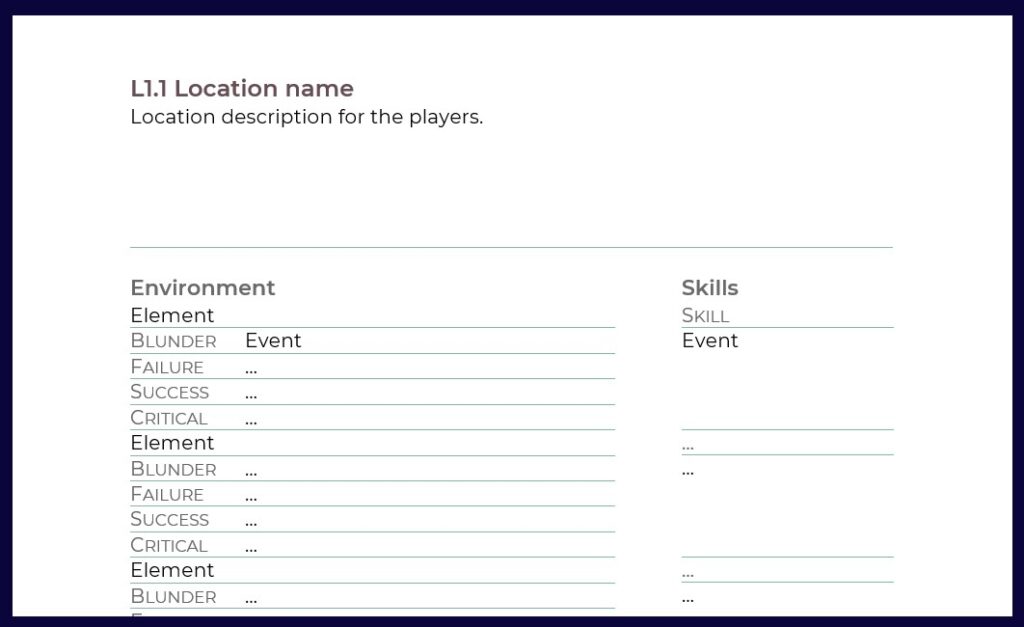
Each place in each scenario is composed of 4 pages and in them you have all the crucial information for your adventure. This is the great advantage of the narrative map: it limits you when filling out the template and allows you to easily consult the important information for the plot to evolve.
In the first two pages you have the first 8 parts of the place:
- Its description.
- How it is overcome.
- Its specific scenery.
- What skills allow you to do something important.
- What traps are there and where they are placed.
- Which of the rewards are found in the place.
- A conversation section, as a guide to give key information.
- Another section for combat to know when it happens and how it can end.
The last of the parts, the puzzle, is located on the other two pages. These are designed for you to write both the information that only you can know and that which you will read to the players. In fact, you can print this last sheet and draw by hand on it if you need it.
The Two Formats of the Narrative Map
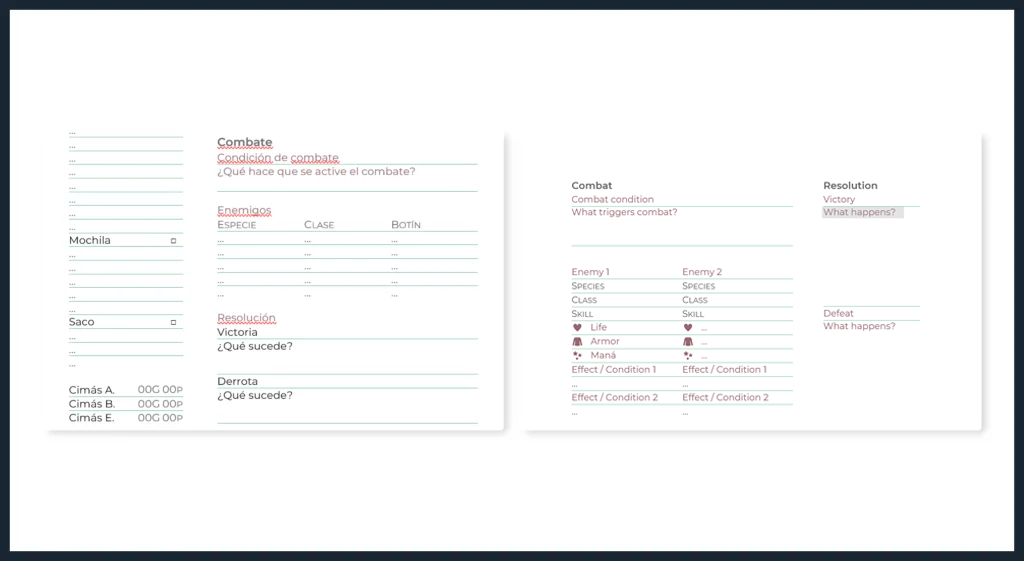
And, although it is true that it is very comfortable, there are people who prefer to control the enemies and have more space to write dialogues. Sometimes a phrase is enough to improvise on it. But at other times it is more comfortable to read directly a written phrase because maybe you want to give very specific information.
That’s why there are two models of narrative map. In the second, the dialogue part occupies an entire page and the combat part is located on another page for him alone. However, the part to create your puzzle is reduced to the solution of it.
Two formats for different needs.
The Origin of the Narrative Map
During the development of Kat-Patum humans, I asked myself a simple question: why not have a simple template, quick to fill out and easy to consult during the game?
Like you, I started searching on the internet. I told myself: —there must already be a template or some kind of information about it. But no, I didn’t find anything about narrative maps that would help game directors during a role-playing game. The little I found was more related to writing and it wasn’t what I had built in my head either.
And that’s because I see a problem with campaign books: generally you have to read them all before playing or even memorize some information. They are not made to have them during a game. So I asked myself why not build something that allows you to consult your One Shot in 15 or 20 minutes before starting to play?
The Evolution of the Template
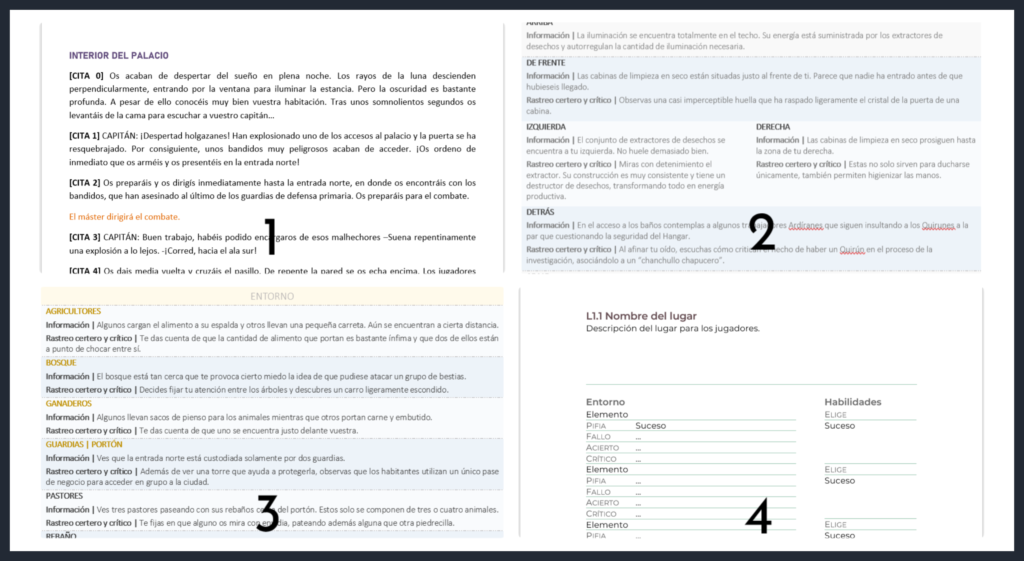
It was then that I decided to make the first version. We had to go to the first game test in an event held in Pontevedra, Galicia. The event was Xornadas Meigas, which we were very excited about for three simple reasons:
- It shared part of our name.
- It was a small event.
- It was close to home (no transport costs, yay!).
This was very important because we could make ourselves known. And we were just starting out. The pity was that then came the pandemic and we could not continue testing physically.
The map we took to these tabletop role-playing days was thought of as a compass. So the player had to indicate which direction he looked: right, left, etc. Just like a map. The biggest problem with this structure was that it cut the rhythm of the game a lot. It had to be changed.
In the next template, which was tested at NetCon 2020, I made a simple change: from being oriented like a compass to focusing on what the player said. In this way, if the player wanted to use a whiteboard eraser, he would not have to say “I look to my right” first.
This worked perfectly, because I only had to listen to what they told me and pay attention to whether that object or piece of furniture was noted with an important interaction. Perfect if someone likes to thoroughly search a place. Now all that remained was to adjust the important information to create a template that would limit creativity.
At first I researched all possible narrative plots and the most used resources to create plot twists. I wanted to add something complete and that would summarize it. The first time I ended up creating an open template, which wasn’t bad at all. You could write whatever you wanted, but it started to look like a game director’s monologue, too many descriptions and dialogues. And I wanted to avoid this at all costs.
So finally I left the template in rest for a year while we advanced with the organization of the team (and how much work that is not seen). This allowed me to understand that the first thing was to have a legible font with a good size, and from there make the template. With this came the decisive solution: having all the information of a place in 2 pages.”
ENDING
So the final template arrived, now in 2023. It is fully adapted to the Kat-Patum humans rules, but the universal template should arrive someday. For now, we leave you all the resources so you can take advantage of it in your games, whether they are Kat-patum or not. You just have to subscribe to our newsletter.